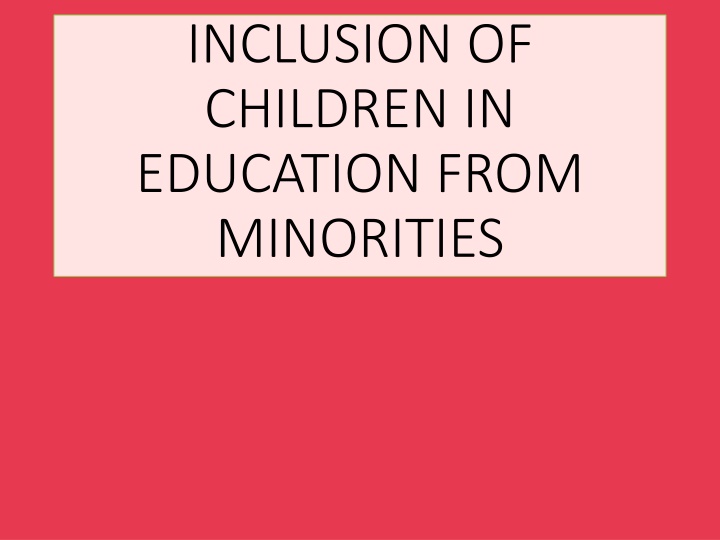
Enhancing Educational Inclusion for Minority Children
Explore the meaning of minority, constitutional provisions, constraints faced by minority children, and possible solutions to improve their educational experience. Learn how addressing cultural diversity, providing language options, and establishing inclusive education practices can benefit minority students.
Download Presentation

Please find below an Image/Link to download the presentation.
The content on the website is provided AS IS for your information and personal use only. It may not be sold, licensed, or shared on other websites without obtaining consent from the author. If you encounter any issues during the download, it is possible that the publisher has removed the file from their server.
You are allowed to download the files provided on this website for personal or commercial use, subject to the condition that they are used lawfully. All files are the property of their respective owners.
The content on the website is provided AS IS for your information and personal use only. It may not be sold, licensed, or shared on other websites without obtaining consent from the author.
E N D
Presentation Transcript
INCLUSION OF CHILDREN IN EDUCATION FROM MINORITIES
Meaning of Minority By the term'Minority' we mean the people of smaller number in comparison of the entire society. A minority is a ethinic, racial, religious or other group having a distinctive presence within a large society.
Meaning of Minority Richard T. Schaefer described a minority as a sub- ordinate group whose members have significantly less control or power over their own lives than the members of a dominant group have over their.
Facilities provided by Constitution The Article 30 of the Constitution guarantees the minorities certain cultural and educational rights to establish and administer educational institutions of their choice, whether based on religion or language. Article 30(2) states that "The state shall not in granting aid to educational institution, discriminate against any educational institution on the ground that it is under the management of a minority, whether based on religion or language.
CONSTRAINTS FACED BY CHILDREN OF MINORITIES Unfriendly school and classroom environment. Cultural and religious domination. Early withdrawal of male children. Early withdrawal of female children. Unfulfilled demand for adequate number of Urdu medium schools or at least Urdu as second language. Lack of Urdu language teachers
Possible by- Understanding the educational needs. Addressing the exclusion of minority children. Opening of schools in Muslim concentrated area. Providing the option of learning'Urdu' as Second language.
Possible by- Sensitizing all the teachers to the issue of cultural and religious diversity especially in relation to Muslim. Celebrating the Muslim festivals.
Possible by- Providing Maktab/Madrassas to serve as institution for providing bridge education. Evaluation of students studying in Maktabs/Madrassas to be linked to the assessment system in regular schools. Setting up schools or centres with adequate teachers for particular time in the premises of Maktab/ Madrassas. Encouraging inclusion practices by teachers.
Possible by Recruiting of more Urdu teachers in Muslim concentrated areas. Opening up girls schools in Muslim concentrated areas. Encouraging the training of teachers in multilingual education.
Inclusion in Education Will help - To fulfill their educational needs. To address their disadvantages. To cope with regular school system. To solve the issue of discrimination. To get rid of cultural and religious domination. To remove social distance. To get adequate security and emotional support.
Inclusion in Education will help- To access the educational opportunities. To get the recognition from the peers. To avoid cultural and religious as well as linguistic exclusion.
